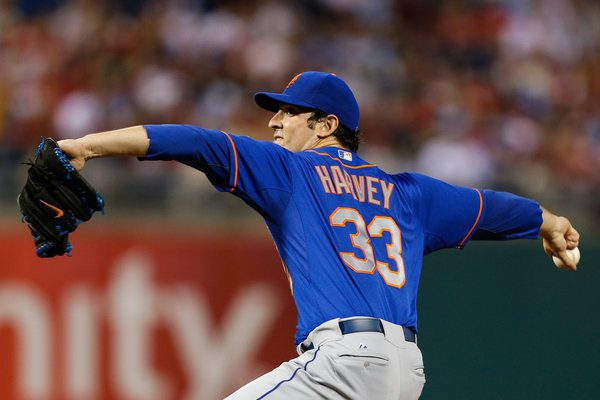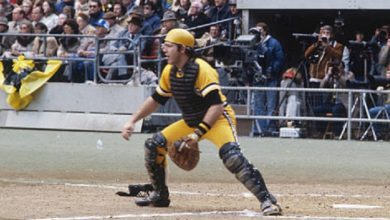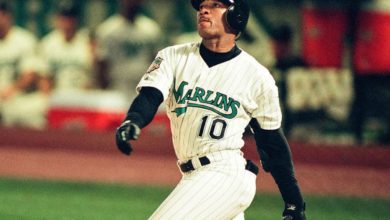

In previous articles, I predicted that New York Mets would not only surprise a lot of people, but contend for the National League Wild Card this year. They have disappointed thus far, at 17-27 going into Memorial Day Weekend, but the National League East is doing its best to keep the Mets in contention. Despite being 10 games under .500, the New York Mets are 10 games out of first place going into a weekend series against the Atlanta Braves. Whether the Mets climb back into contention or continue to disappoint will depend on the key areas below.
Starting pitching
The New York Mets’ starting pitching has been decidedly mixed in its results. At one extreme, there’s Matt Harvey, whose career has begun in historically good fashion. Harvey has four good pitches, all of which he throws with command to get outs. He’s a big presence on the mound, literally and figuratively, and he pitches with power (his fastball tops out in the upper 90s) and conviction. He can battle through tough situations, and he’s already being lauded for his presence among his teammates. He seems like the real deal, and he can even hit a little bit. He’s emerging as one of the truest aces in baseball.
Veteran starter Shaun Marcum, who seemed a decent candidate to be a solid number-three starter, missed a stretch of April with nerve inflammation in his neck. He’s been up and down since coming back, but as he settles in, he should be a pitcher the Mets can count on for quality starts more often than not.
By and large, the New York Mets starting pitching has otherwise been a disappointment: The starters’ collective ERA is 4.37, including Harvey’s 1.93. Dillon Gee and Jonathon Niese — the incumbent number-two starter — have struggled to go deep into games, putting pressure on an already beleaguered bullpen. Several times in the past week alone, New York Mets starters have spotted the opposition two or three runs early in the game. This clearly is not sustainable.
One somewhat hopeful sign has been Jeremy Hefner. Hefner’s season has been up and down thus far, but he’s shown an ability to battle through tough innings and pitched quite solidly at times. When his curveball is sharp, his tenacity makes him another middle-rotation starter who can soak up innings. He could be a solid fourth starter, behind Harvey and Marcum and Niese, and would be a more than adequate fifth starter when Zack Wheeler is promoted later in the season.
Grade: B-
Relief pitching
Last season, relief pitching was a major Achilles’ heel for the Mets. This season has been similar, with the bullpen ERA lingering at or near the bottom of major-league rankings. The relievers are not entirely to blame; the starting rotation’s frequent failure to last more than four or five innings has put a lot of physical and mental strain on the bullpen, contributing to its erratic performance. Of course, this is not the only explanation, as several decent starts and gritty comebacks have been spoiled by meltdown innings from the pen. At times, it seems Citi Field is where previously reliable relief pitchers lose their mojo. The bullpen has improved, of late, and its continued improvement will somewhat hinge on the performance and durability of the starting rotation. “Matt Harvey and pray for rain” does not a good bullpen make.
The lone bright spot for the bullpen has been closer Bobby Parnell. Parnell is 4-1, with six saves and a 0.89 WHIP, and his handful of blown saves have been the result of shoddy defense (most recently, Ike Davis whiffing a Brandon Phillips checked-swing into a double). He seems to be evolving into a true closer who wants the ball in the clutch and knows how to pitch instead of just relying on his upper-90s fastball to try and blow people away.
Grade: C+
Defense
The New York Mets’ defense has been, all things considered, fairly average, though it’s hurt them late in games a few times, mainly with Parnell on the mound (the aforementioned Davis blunder, a poorly thrown ball by Ruben Tejada and a misjudged shallow fly by Collin Cowgill). A surprising weak link, of late, has been Davis, whose previously outstanding defense has begun to mirror his woes at the plate. But overall, the defense has been solid, consistent and relatively error-free. Tejada plays a steady, dependable short, with occasional acrobatic flashes despite relatively few “web gems.” David Wright‘s defense has mostly been excellent, and Lucas Duda‘s outfield defense has leveled off to become mediocre but not damaging. The rest of the New York Mets outfield — though its hitting problems are well documented — has produced good range, strong arms and a good amount of defensive promise. Marlon Byrd has several outfield assists and has covered a good amount of ground wherever he’s played; Juan Lagares has played a speedy, assertive center field; Mike Baxter is rangy and athletic; and recent acquisition Rick Ankiel is known to be an excellent outfielder with a cannon for an arm. Jordany Valdespin, a converted second baseman, has shown good speed in the outfield and seems to be improving his positional comfort.
Grade: B
Hitting
The New York Mets’ hitting has been defined by inconsistency. They’ve shown signs of being hard to put away, staging numerous rallies and continuing to show they can score with two outs. They have a couple of guys with power and a couple of guys with speed. Two major problems plague them: their frighteningly indiscriminate tendency to look at pitches down the middle and Ike Davis.
First, the Ike Davis problem. Davis’ atrocious numbers — one hit in his last 40 at-bats — do not, if you can believe it, do his woes justice. His stance is too wide, his pitch recognition is awful and he seems as though he will swing a mile ahead of the laziest, loopiest curveball two or three times in a row. His recognition of the strike zone is similarly head-scratching, exacerbated by the fact he stands extremely far away from the plate. His tendency to roll his eyes, pout and mope after seemingly every borderline strike is alienating him from the umpires (who are often none too diplomatic, as I mentioned in an earlier post) as well as fans. He’s behind the fastball and ahead of the breaking pitch, and when he does hit the ball, his power is dissipated by his wide-open stance and a front hip that seems to be halfway to the dugout when his bat crosses the strike zone. He rarely makes a productive out. He personifies the expression “hole in the lineup” and, at long last, the New York Mets are considering demoting him to the minor leagues.
As for the “take a strike” approach, it’s been oft-discussed of late, not just regarding the New York Mets’ extreme application thereof but in general. Taking a strike is, in many situations, highly advisable. But there are times, situations and pitchers that not only don’t require it, but render it counterproductive. Some pitchers will take full advantage of getting a free first strike, and this puts New York Mets hitters at a disadvantage in many situations. This is particularly true of Duda, who has both power and versatility at the plate and yet too often seems to take hittable fastballs through the heart of the zone. If the New York Mets’ selective aggressiveness was to improve, they would go from a team that hits well with two outs and/or two strikes to a team that doesn’t get to two outs or two strikes as often. In a large park, with speedy line-drive hitters, a “small ball” approach is a good thing — but “small ball” and “working counts” shouldn’t put you at a disadvantage and lead to a free first strike for any pitcher who wants one. Taking pitches should work to your advantage, not increase the opposing pitcher’s comfort on the mound.
If the New York Mets can put themselves in more advantageous positions, their ability to hit line drives and take extra bases (their base running has been much more aggressive, which puts pressure on defenses and pitchers, and takes advantage of their decent team speed) will work to their advantage. Right now, they too often seem to approach at-bats like a power-hitting team, and this doesn’t favor them. With speedy role players and two veritable line-drive gap hitters in Wright and Daniel Murphy, along with a powerful lefty with a good eye in Duda, there’s not much excuse for the offense not to be consistently better. Until they learn to make pitchers pay for throwing “get it over” fastballs, and drop the yawning black hole that is Ike Davis from their lineup, they will continue to score sporadically.
Grade: B-
Coaching
I’m not sure Terry Collins knows what to do with the Mets, and this seems to be a problem. I’ve never been a fan of the “old-school tough guy” approach, and he isn’t even consistent about that. Sometimes he plays the “I care about my boys” role, and sometimes he does things like throw his rookie under the bus when an opposing team throws at him for looking at a home run for more than a split second. He changes the lineup too often, and refuses to sit Davis despite the fact he isn’t just slumping but speedily regressing. The New York Mets seem to never be out of a game, which is a good thing; they also seem never to put teams away when they get pitchers in trouble, which is a bad thing. The ability to play from behind is necessary but not sufficient, and until the New York Mets gain more of a proverbial killer instinct, they’ll stay mediocre. To me, this starts at the top. Collins has to infuse the Mets with the mentality of a team that puts other teams away and plays with authority. In the long run, being scrappy just isn’t enough.
Grade: B-
Overall
The New York Mets have flaws, but so do other teams that succeed. They also have young talent, a veteran superstar, a blossoming ace, a developing power closer and a historically good young ace. They have another potential ace in Zack Wheeler, and a legitimate run-producing catcher in Travis D’Arnaud, poised for promotion. The sum of their parts might not be overly daunting, but the New York Mets aren’t doing enough with what they have. Nobody thought much of the Oakland A’s or Baltimore Orioles last spring, either; they, and many other teams before them, mastered the art of maximizing their talent and rallying around leadership and one or two stars. The New York Mets have a veteran leader in Marlon Byrd, a versatile fourth outfielder who can play all three spots and has hit well in the clutch. They have David Wright, a perennial All-Star who is having one of his stronger overall seasons. They have a young lefty in Lucas Duda, who has prodigious power and an ability to hit situationally. They have a defensively solid shortstop in Ruben Tejada, who has shown some ability to deliver clutch singles and rarely gives away outs. Many teams have succeeded with a similar constellation, but their approach has to change. They can’t only play well with their backs against the wall, and they have to get their starting pitchers to last deeper into games so their relievers aren’t torched halfway through a homestand or road trip.
The New York Mets have to decide which version of themselves they’re going to be, while there are still many months left in the season. The rest of the National League East is playing below expectations (except for the Marlins, who seem intent on proving themselves the worst franchise in mainstream American sports), and there is still time. 17-27 is just not good enough for a team with this many promising players and solid parts.
Final Grade: C+
Keys to improvement
- Demote Ike Davis and move Lucas Duda to first base. Davis’ defense, previously the only reason to keep him around, has deteriorated to the point where Duda wouldn’t be that much of a dropoff.
- Move John Buck back up in the order.
- Be more aggressive at the plate, team-wide, and abandon the power approach — play gap to gap.
- Promote David Aardsma, recently signed, who can help buttress the beleaguered bullpen.
Suggested lineup
- Daniel Murphy, 2B (He’s done surprisingly well at leadoff, and with his tendency to shoot the gaps, he’s a nice substitute for having a speed merchant at the top as he’ll often wind up at second base.)
- Mike Baxter, LF (He’s a lefty line-drive hitter with decent athleticism, and he’s shown he’s fairly centered during clutch at-bats.)
- David Wright, 3B
- Lucas Duda, 1B
- John Buck, C
- Marlon Byrd, RF
- Rick Ankiel, CF
- Ruben Tejada, SS
There are almost 120 games to go in the season, and the New York Mets are currently playing a team that’s above them in the division. There’s still time to turn the season around, but first the New York Mets must learn to maximize their talent. Ya gotta believe.





